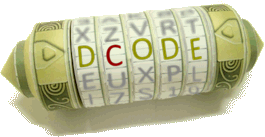Tool for counting with counting marks (numerical system for counting by addition of units), usually represented by tally bars and grouped by 5.
Tally Marks - dCode
Tag(s) : Communication System, Mathematics, Symbol Substitution
dCode is free and its tools are a valuable help in games, maths, geocaching, puzzles and problems to solve every day!
A suggestion ? a feedback ? a bug ? an idea ? Write to dCode!
Tally Marks
Tally Marks Counter
Tally Marks Notation Encoder
Answers to Questions (FAQ)
How to count using the tally marks unary system?
The unary system based on successive marks consists of recording each addition of n units by n marks (generally lines, bars or sticks). The system uses a single symbol (the system is said to be unary) and allows the count to be updated (for numbers up to a few tens, beyond that, the system is neither practical nor efficient).
The use of tally marks is to group each set of 5 to facilitate counting
Several graphic variants are possible as the square
The unary counting system by marks is often used for a count of days remaining, a calculation of scores, number of points of a match, etc.
How to read the tally marks unary system?
How to recognize the tally marks unary system?
Usually marks / lines / sticks are written in lines or in groups. The symbols are generally all the same and simple (bars or dots).
Source code
dCode retains ownership of the "Tally Marks" source code. Any algorithm for the "Tally Marks" algorithm, applet or snippet or script (converter, solver, encryption / decryption, encoding / decoding, ciphering / deciphering, breaker, translator), or any "Tally Marks" functions (calculate, convert, solve, decrypt / encrypt, decipher / cipher, decode / encode, translate) written in any informatic language (Python, Java, PHP, C#, Javascript, Matlab, etc.) or any database download or API access for "Tally Marks" or any other element are not public (except explicit open source licence like Creative Commons). Same with the download for offline use on PC, mobile, tablet, iPhone or Android app.
Reminder: dCode is an educational and teaching resource, accessible online for free and for everyone.
Cite dCode
The content of the page "Tally Marks" and its results may be freely copied and reused, including for commercial purposes, provided that dCode.fr is cited as the source.
Exporting the results is free and can be done simply by clicking on the export icons ⤓ (.csv or .txt format) or ⧉ (copy and paste).
To cite dCode.fr on another website, use the link:
In a scientific article or book, the recommended bibliographic citation is: Tally Marks on dCode.fr [online website], retrieved on 2025-04-15,

.png)
.png)
.png)
.png)
.png)